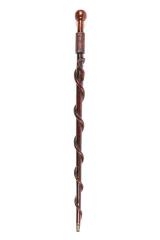Comments and Tags
Be the first to comment on this item!
Clothing Accessories
Clothing and Accessories
Men's Clothing ➔ Cane
Identifier:
148326Description:
This cane is made of wood and has a handle carved into the shape of a man's head. It also has a metal ferrule and there are various carvings of names and images throughout the shaft. According to museum records, it belonged to Senator Arthur H. Vandenberg.Date:
circa 1940Materials:
Wood, MetalDimensions:
36"" h 2"" wCurrent Location Status:
On ExhibitCollection Tier:
Tier 2Source:
Gift Of Mrs. Harriet BurrRelated Entities:
Burr,Harriet (donor) Senator Arthur H. Vandenberg (used by)Born in Grand Rapids in 1884, Arthur Hendrick Vandenberg represented the state of Michigan as a United States Senator from 1928-1951. Vandenberg became interested in politics after receiving his law degree from the University of Michigan in 1901 and serving as editor-in-chief of the Grand Rapids Herald from 1906-1928. After the death of US Senator Woodbridge Nathan Harris in 1928, Michigan governor Fred Green appointed Vandenberg to the vacant position. Vandenberg was then successfully elected for four consecutive terms in the US Senate under the Republican Party platform.
During his time representing Michigan, Vandenburg worked heavily on the Reapportionment Act of 1929, which requires redistricting of the US House of Representatives using information from the national census. He acted as a strong opponent to President Franklin D. Roosevelt’s New Deal measures in the 1930s, pursuing a policy of “fiscal responsibility, a balanced budget, states’ rights, and reduced taxation.” Since 1929, he served on the US Senate Foreign Relations Committee and is known for his “speech heard round the world” where he announced his decision to follow a policy of internationalism during World War II. Vandenberg is likely best known for the Vandenberg resolution, a 1948 agreement key to signing the North Atlantic Treaty, which established NATO. During and after World War II, Vandenberg was a champion of the Republican Party and gained much support for a presidential nomination, yet declined to run.
In 1950, Arthur Vandenberg developed cancer but maintained his service in the Senate until his death in April 1951. He is buried in Oak Hill Cemetery in Grand Rapids.


